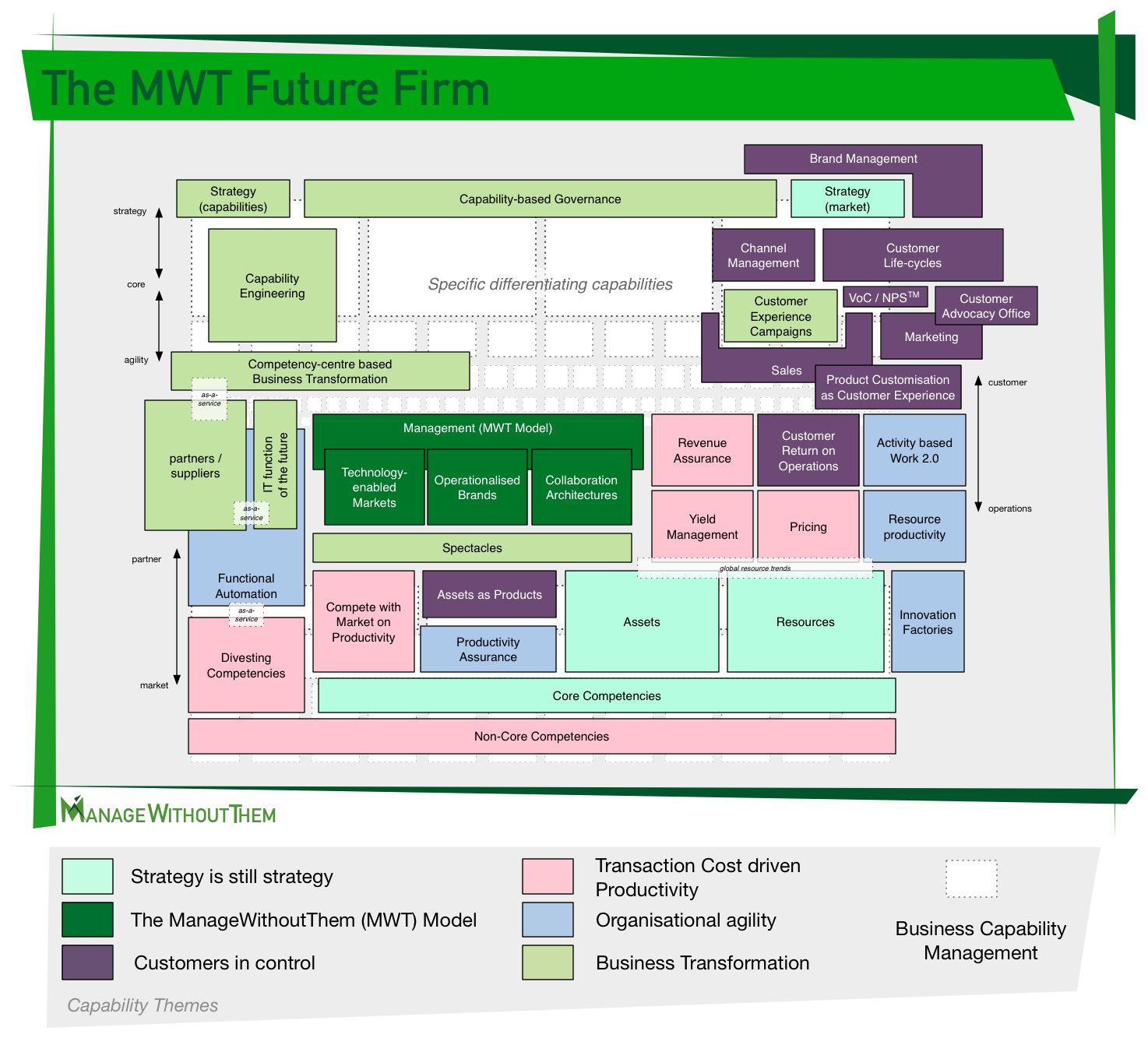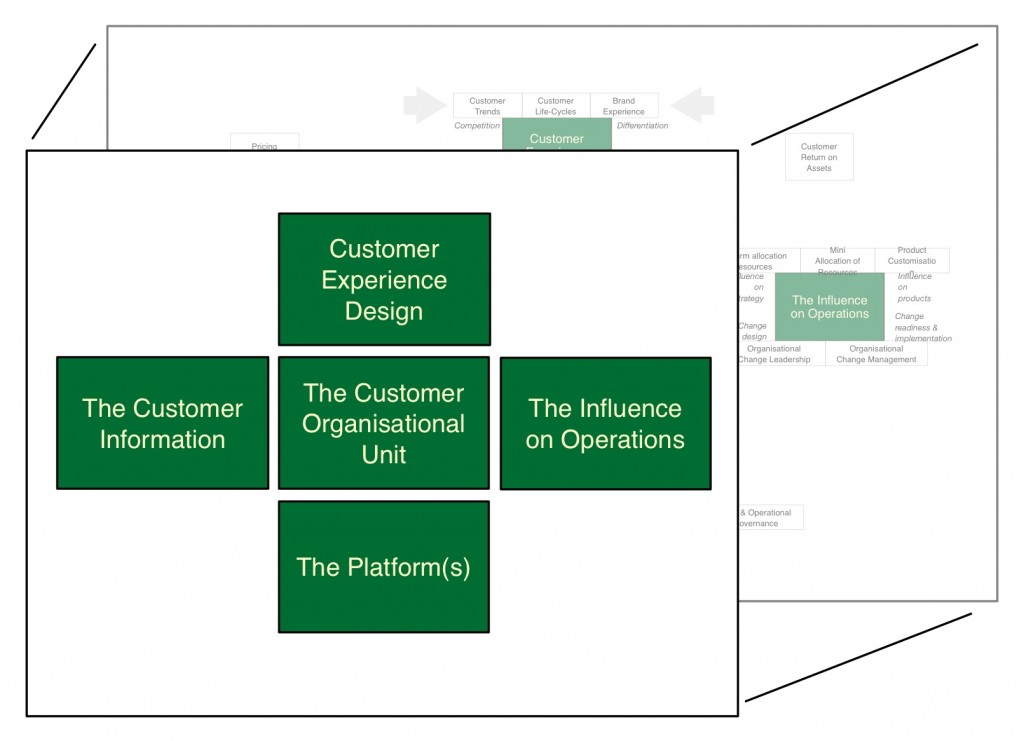The MWT Future Firm is a generic business capability model highlighting the capabilities required to be a successful organisation of the future. It also contains plenty of white space to include your specific business capabilities; so, you’ll still need to utilise business capability modelling techniques to make this model specific to your organisation.
The MWT Future Firm balances back-to-basics discipline around the nature of strategy with capabilities that respond to key trends in mobility, digitisation, innovation, customer-focus, and transaction cost economics that are forcing our organisations to evolve. The MWT Management Model is also embedded within the MWT Future Firm.
Each component of the MWT Future Firm represents a traditional management concept reshaped by these trends, or a capability that can be matured through the capability engineering process. Of course, each capability represents a combination of people, process, information, and technology consistent with the principles of capability-based planning and governance.
Strategy is still strategy
Any backlash against strategy has been a backlash against bad strategy and a call for improved execution – rather than strictly anti-strategy. However, now strategy as a coordinating function must co-exist with operationalised brands as the primary horizontal organising mechanism of the firm (i.e. “live the brand” and “values-based management” initiates). Design thinking, idea factories, “agile”, and traditional portfolio management approaches also help bridge the strategy / execution gap.
The MWT Model in the future firm
The MWT Model is an important part of the MWT Future Firm. As described elsewhere, the MWT Model changes the management process itself from planning, monitoring, and controlling to:
- Technology-enabled markets – to utilise collaboration platforms, market metrics, and exchanges to introduce market-based coordination inside the firm and across partner ecosystems
- Operationalised brands – to make the organisations brand (and values) the primary horizontal organising mechanism for all peer-to-peer, performance management, and customer-facing decisions
- Collaboration architectures – to continuously optimise collaboration around outcomes rather than roles, hierarchies, and out-dated management norms
In the firm of the future, the management function itself runs the risks of losing control (or more likely, losing relevance) unless the MWT Model is implemented.
Customers in control
I’m sorry but saying that you are going to put your customers at the centre of everything you do is not customer focused. Do you know what’s at the centre of everything your customers do? Your customers. Recognising that your customer life-cycles go way beyond your organisation is the first step to true customer centricity.
The second step of customer centricity is recognising that despite everybody wanting to own the customer in your organisation a comprehensive approach to customer centricity takes an organisation-wide approach. In fact, all of the pieces are readily available if you just coordinate them effectively:
- Customer information – The voice of the customer comes in many forms. You have to listen to your customers. But you also have to listen to those in your organisation who listen to your customers. You also have to read the tea-leaves in your data that properly integrated and interpreted tell you what your customers are thinking, experiencing, or about to do – either individually, in aggregate, or by proxy – either before or after they do.
- Customer platforms – The platform goes beyond technology. It is about systemisation, reinforcing behaviours. It’s about making customer orientation efficient.
- Customer organisation – The Customer Advocacy Office instead takes the lead in the critical customer orienting activities proven to improve customer experience and retention – and uses these to marshal the organisation around it’s customers. It’s insufficient to represent customer only only at customer interaction points; the customer must also be represented within strategy, investment, planning, product, and service management processes.
- Customer experience – Exceptional customer experience doesn’t happen by accident. While you can’t dictate to your customers what their ideal experience consists of, you must design and maintain an idealise optimal experience for each of your customer archetypes.
- Customer return on operations – Organisations are influenced by the needs of many stakeholders and economic forces. Uplifting your organisation’s customer orientation is by definite at odds with the incentives, behaviours, and decisions which have evolved from the other forces. Customer orientation cannot disregard these other business imperative – however, it must be part of the rebalancing of the organisation as a whole. Without influence all talk of customer orientation is veneer.
Customer competencies can no longer afford to operate as silos. Introducing a platform-based approach, Customer Experience Campaigns provide a mechanism for systematically amplifying every positive customer experience and recovering every negative customer experience.
Customer Experience Campaigns link your idealised designed customer experience, with you customer data, and with your product strategy to bridge the gap between your brand and your product & service delivery.
Transaction Cost Driven Productivity
Continuously reducing transaction costs driven by improvement in internet and communication technologies mean impact both the boundaries of firms and the ability for firms to optimise productivity internally. In fact, early internet proclamations that the internet meant the end of the large corporate may not turn out to be true.
The first stage of transaction cost driven productivity is “industry jumping” for specialised productivity capabilities. For example, the telecommunications industry has for a long time invested in churn prevention analysis and sophisticated whole of enterprise revenue assurance capabilities. These capabilities are now available to all industries. While the unique features of the telecommunications industry caused heavy investment in creating these specialised disciplines, the economics of lowering transaction costs means that these capabilities are often the quickest path to competitive advantage is other industries.
Similarly, the cost fixed costs associated with the airline industry created sophisticated pricing and yield management disciplines to maximise the make of expansive assets. Lowering transaction costs cause these discipline to industry jump in the same way with all asset-heavy, price sensitive industries able to benefit from these disciplines because of reduced implementation costs.
In fact, many IT -driven trends such as “big data” represent the low cost versions of what some industries have been doing for years. Though these low hanging fruits are actually only the top of the iceberg for transaction cost driven productivity improvements!
The firm of the future is always competing with the market for productivity. The ability to partner, divest competencies, and minimise the dependancy on functional (i.e. siloed) organisation is a continuous process as transaction costs lower and new opportunities utilise the market to provide competencies open up.
Organisational agility
It is not enough to improve the agility of your decision making. It is not enough to improve the agility of your software development teams. It’s also not enough to improve the value extracted from human resources buy better harnessing creativity to foster innovation. These are now the price of admission.
Real organisational agility ensures these initiatives are actually creating value for your organisation. Rather than just acting as a catalyse for change, breaking down barrier, and running innovation as an exception. When agile becomes agility it has to fully integrate with the organisation rather than run as an exception.
Business transformation
The firm of the future doesn’t happen by itself. Making the required transformation in your business requires a structured approach. Traditional business transformation approaches – i.e. heavy transformation plan + heavy change management – don’t work when there is uncertainty – and there is always uncertainty in large-scale change.
A better approach to business transformation is competency-centred based. By designing a portfolio of competency centres, each with a focus and progressive service catalogue a lean transformation agenda can be managed in parallel with managing each competency centres’ maturity.
The approach makes competency centres the machinery of business transformation.
Posts relating to business architecture:
- Trying to Implement the Functional OrganisationIn that perverse type of functional organisation that has a functional business unit for each profession, there is a predictable progression for each function. The function cannot succeed until it is centralised The function cannot succeed until it has the sponsorship of the CEO The function cannot succeed until it has its own “Chief xxxx Officer” The function cannot ...
- Shifting to a Data-enabled Organisation – from I.T.’s PerspectiveI.T. gets a bad wrap in some information management initiatives. I prefer to take the approach that many IT disciplines are helpful for better information management. The shift from I.T.’s perspective often looks like this:
- More capability-based planning goodnessGood capability-based planning article: http://fia.workem.org/index.php?option=com_content&view=category&layout=blog&id=14&Itemid=111
- The IT Department of the Future… doesn’t exist Good article, including the simple fact: In the industrial company of the future, there won’t be a separate IT department. From: http://www.strategy-business.com/article/The-Thought-Leader-Interview-Bill-Ruh?gko=9ae51
- Avoiding the B.A.I.T. view of Business CapabilitiesReference material added here: Breaking free of B.A.I.T. -based Capabilities
- The No ICT Strategy OrganisationThe idea of business / IT alignment is completely at odds with the challenge of business agility. You can never align all-of-the-business with all-of-the-IT. You can only ensure that the business capabilities your organisation’s operating model depends on sufficiently utilise information technology in order to ensure competitive levels of productivity, optimal customer experience, and coordination ...
- Capability-based Governance and business architectureCapability-based Governance and business architecture: http://www.strategy-business.com/article/Enterprise-Architecture-Planning-2.0?gko=43bf5
- Getting closer to the future of the IT functionMy views on business capability-based governance extend to the idea that an “IT function” doesn’t really make any sense at the highest governance levels. However, the implications of this are significant. So, in the meantime….
- Business Architecture as Foundation for TransformationGood overview of how the business architecture discipline bridges the strategy / executive gap (i.e. transformation) The Business Architect as Strategist from Accelare
- Industrialised Adhocracy and The Future of WorkExcellent overview on Industrialised Adhocracy and The Future of Work: http://www.procurementandsupply.com/resource/David%20Moloney%20-%20Industrialised%20Adhocracy%20-%202nd%20CPO%20Exchange%20-%20July%202014.pdf




Leave a Reply